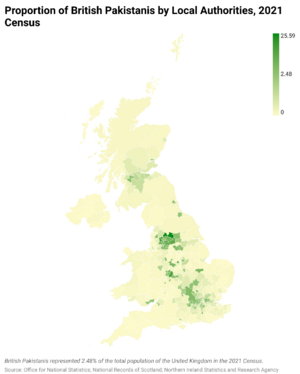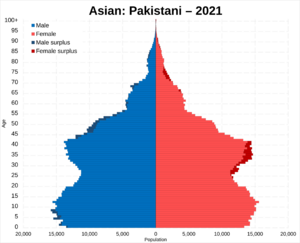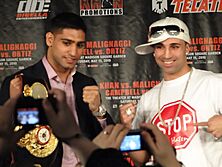British Pakistanis facts for kids
| بَرِطانِیہ میں مُقِیم پاکِسْتانِی | |
|---|---|
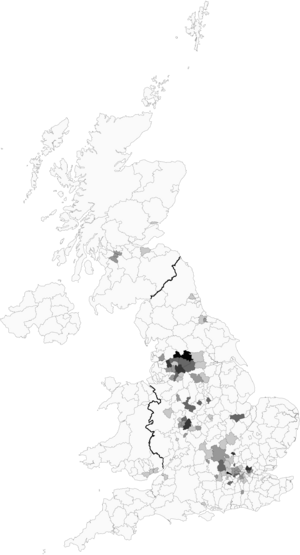
Distribution by local authority in the 2011 census.
|
|
| Total population | |
Northern Ireland: 1,596 – 0.08% (2021) |
|
| Regions with significant populations | |
| Languages | |
| English (British and Pakistani) · Urdu · Punjabi · Pashto · Sindhi · Balochi · Brahui · Kashmiri · Khowar · Shina · Balti · others | |
| Religion | |
| Predominantly Islam (92.6%); minority follows other faiths (1.0%) or are irreligious (1.2%) 2021 census, NI, England and Wales only |
|
| Related ethnic groups | |
|
British Pakistanis are people living in the United Kingdom who have family roots in Pakistan. This includes people born in the UK with Pakistani heritage, and those who moved to the UK from Pakistan or other countries. They are also known as Pakistani British people or Pakistani Britons.
The UK has the largest Pakistani community in Europe. Over 1.6 million British Pakistanis live here, according to the 2021 Census. They are the second-largest ethnic minority group in the UK. They are also one of the biggest Pakistani communities living outside Pakistan.
People started moving to the UK from the area now known as Pakistan in the mid-1800s. This was when parts of Pakistan were under British rule. Many served as soldiers in the British Indian Army. After World War II and Pakistan's independence in 1947, more people came to the UK. This was especially true in the 1950s and 1960s. Pakistan was part of the Commonwealth of Nations, which made it easier.
Pakistani immigrants helped fill job shortages in British industries. These included steel, textiles, and engineering. The National Health Service (NHS) also hired doctors from Pakistan. The British Pakistani population grew from about 10,000 in 1951 to over 1.6 million in 2021. Most live in England, with many in Scotland, and smaller numbers in Wales and Northern Ireland.
British Pakistanis have contributed a lot to British society. They have influenced politics, culture, economy, and sports. While some families faced poverty in the past, many have made great progress. For example, the 2021 Census showed high levels of homeownership among British Pakistanis.
Contents
History of British Pakistanis
Early Arrivals in Britain
People from South Asia, including areas now in Pakistan, came to Britain a long time ago. Some arrived as early as the mid-1600s. They often worked for the East India Company as sailors. These early immigrants sometimes married local British women. This was because there were few South Asian women in Britain.
During the time of British rule in India, more Asians came to Britain. They worked as traders, students, or domestic helpers. Some settled down after being treated badly or left behind by ship captains. Many early Pakistanis came to the UK to study. They attended famous British universities. An example is Muhammad Ali Jinnah, who later founded Pakistan. He studied law in London in the 1890s.
Life Before Pakistan's Independence
Before 1947, Pakistan was part of British India. Many early Pakistani settlers moved to the Midlands region of Britain. When World War II started in 1939, many worked in factories. These factories made weapons in places like Birmingham. After the war, many stayed in Britain. They found more jobs available.
In 1932, a survey estimated about 7,000 Indians lived in the UK. This included people from areas that are now Pakistan. Many Muslim soldiers from what is now Pakistan fought with the British Army. They helped during both the First and Second World Wars. After their service, most returned home. However, many came back to Britain in the 1950s and 1960s. They helped fill job shortages.
Migration After Independence
After World War II, the British Empire changed. Pakistan became independent in 1947. This led to more Pakistanis moving to the UK. Many came during the 1950s and 1960s. Some had first moved to Pakistan from India. It was easier to migrate because Pakistan was a member of the Commonwealth. British employers invited Pakistanis to fill jobs.
As Commonwealth citizens, they had many British rights. They found jobs in textile factories in Lancashire and Yorkshire. They also worked in manufacturing in the West Midlands. Car production and food processing industries in Luton and Slough also hired them. Pakistani workers often took night shifts or less popular hours.
Many people also came from Mirpur in Azad Kashmir. This happened after the Mangla Dam was built in the late 1950s. The dam flooded many villages. About 5,000 people from Mirpur moved to Britain. The British company that built the dam helped them. People from other parts of Pakistan also came to the UK for jobs.
In the 1960s, many educated Pakistanis arrived from cities. They were teachers, doctors, and engineers. They often settled in London for more job chances. Most Pakistani medical staff joined the National Health Service.
Later, laws like the Commonwealth Immigrants Act 1962 limited new immigration. However, family members could still join relatives already in the UK. Many early Pakistani workers planned to return home. But they decided to stay permanently. They saw a better future for their children in Britain.
When British industries declined in the 1970s, many British Pakistanis lost jobs. It was hard to switch from factory work to service jobs. This was especially true for those with less education. As a result, more British Pakistanis started their own businesses. For example, in 2004, one in seven British Pakistani men worked as taxi drivers. While some families faced poverty, many have improved their living situations.
Where British Pakistanis Live
| Region / Country | 2021 | 2011 | 2001 | 1991 | ||||
|---|---|---|---|---|---|---|---|---|
| Number | % | Number | % | Number | % | Number | % | |
| 1,570,285 | 2.78% | 1,112,282 | 2.10% | 706,539 | 1.44% | 449,646 | 0.96% | |
| —West Midlands | 319,165 | 5.36% | 227,248 | 4.06% | 154,550 | 2.93% | 98,612 | 1.91% |
| —North West | 303,611 | 4.09% | 189,436 | 2.69% | 116,968 | 1.74% | 77,150 | 1.15% |
| —Yorkshire and the Humber | 296,437 | 5.41% | 225,892 | 4.28% | 146,330 | 2.95% | 94,820 | 1.96% |
| —Greater London | 290,549 | 3.30% | 223,797 | 2.74% | 142,749 | 1.99% | 87,816 | 1.31% |
| —South East | 145,311 | 1.57% | 99,246 | 1.15% | 58,520 | 0.73% | 35,946 | 0.48% |
| —East of England | 99,452 | 1.57% | 66,270 | 1.13% | 38,790 | 0.72% | 24,713 | 0.49% |
| —East Midlands | 71,038 | 1.46% | 48,940 | 1.08% | 27,829 | 0.67% | 17,407 | 0.44% |
| —North East | 27,290 | 1.03% | 19,831 | 0.76% | 14,074 | 0.56% | 9,257 | 0.36% |
| —South West | 17,432 | 0.31% | 11,622 | 0.22% | 6,729 | 0.14% | 3,925 | 0.09% |
| 72,871 | 1.34% | 49,381 | 0.93% | 31,793 | 0.63% | 21,192 | 0.42% | |
| 17,534 | 0.56% | 12,229 | 0.40% | 8,287 | 0.29% | 5,717 | 0.20% | |
| Northern Ireland | 1,596 | 0.08% | 1,091 | 0.06% | 668 | 0.04% | N/A | N/A |
| 1,662,286 | 2.48% | 1,174,602 | 1.86% | 747,285 | 1.27% | 476,555 | 0.87% | |
Population Numbers
The 2021 Census showed that 1,587,819 Pakistanis live in England and Wales. This is about 2.7% of the population. The Office for National Statistics estimates that 456,000 people born in Pakistan lived in the UK in 2021. This makes Pakistan the third most common country of birth in the UK.
Areas with the most Pakistanis include Pendle (25.59%) and Bradford (25.54%). Other areas are Slough (21.65%), Luton (18.26%), and Blackburn with Darwen (17.79%). In Scotland, East Renfrewshire has the highest percentage (5.25%). In Wales, it's Newport (3.01%).
The Pakistani government estimates that 1.26 million Pakistanis in the UK can have dual nationality. This is more than half of all Pakistanis in Europe. Many British citizens also travel to Pakistan each year to visit family.
Most British Pakistanis come from the Azad Kashmir and Punjab regions. Smaller numbers are from Sindh, Khyber Pakhtunkhwa, and Balochistan. The cities with the largest Pakistani communities are Birmingham, Bradford, Manchester, and London.
How the Population Grew
The number of British Pakistanis has grown a lot over the years.
| Year | Population (rounded to nearest 1,000) |
|---|---|
| 1951 (estimate) | 10,000 |
| 1961 (estimate) | 25,000 |
| 1971 (estimate) | 119,000 |
| 1981 (estimate) | 296,000 |
| 1991 (estimate) | 477,000 |
| 2001 (census) | 747,000 |
| 2011 (census) | 1,175,000 |
Where People Live in the UK
Birthplace/year of arrival of British Pakistanis in England and Wales (2021 census) Born in the UK (59.2%) Before 1950 (0.0%) 1951 to 1960 (0.3%) 1961 to 1970 (3.1%) 1971 to 1980 (3.9%) 1981 to 1990 (3.4%) 1991 to 2000 (5.7%) 2001 to 2010 (10.5%) 2011 to 2021 (13.9%)
The 2021 Census shows that many British Pakistanis live in specific areas. The highest percentages are in Pendle (25.59%), Bradford (25.54%), and Slough (21.65%).
| Region | Number of British Pakistanis | British Pakistanis as percentage of region's population | Significant Communities |
|---|---|---|---|
| England | 1,570,285 | 2.80% | |
| North West | 303,611 | 4.10% | Manchester - 11.9%, Rochdale - 13.6%, Oldham - 13.5%, Blackburn With Darwen - 17.8%, Pendle - 25.6% |
| Yorkshire and the Humber | 296,437 | 5.40% | Bradford - 25.5%, Kirklees - 12.6%, Sheffield - 5.0% |
| West Midlands | 319,165 | 5.40% | Birmingham - 17.0%, Walsall - 6.9%, Stoke-On-Trent - 6.0% |
| London | 290,459 | 3.30% | London Borough of Redbridge - 14.2%, London Borough of Waltham Forest - 10.3% |
| South East | 145,311 | 1.60% | Slough - 21.7%, Buckinghamshire - 5.3% |
| Scotland | 72,871 | 1.34% | Glasgow - 5.0%, East Renfrewshire - 5.3% |
| Wales | 17,534 | 0.60% | Cardiff - 2.4%, Newport - 3.0% |
| Total UK | 1,662,286 | 2.48% |
London's Pakistani Community

London has the largest Pakistani community in the UK. In 2021, 290,549 Pakistanis lived in London. This makes up 3.3% of London's population. London's Pakistani community is very diverse. It includes people from different regions of Pakistan.
The largest groups are in East London. These areas include Redbridge and Waltham Forest. You can also find communities in West London and South London.
Birmingham's Pakistani Community
Birmingham has the second-largest Pakistani community in the UK. The 2021 Census showed 195,102 Pakistanis living in Birmingham. They make up 17% of the city's population.
The biggest groups are in areas like Sparkhill and Alum Rock.
Bradford's Pakistani Community

Bradford has the third-largest Pakistani community. In 2021, there were 139,553 Pakistanis there. This is 25.5% of the city's total population.
Large communities are found in Manningham and Toller.
Manchester's Pakistani Community
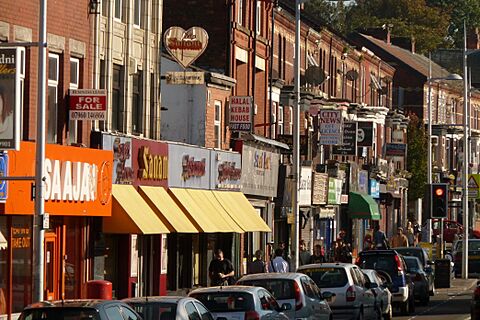
Manchester has the fourth-largest Pakistani community. The 2021 Census counted 65,875 Pakistanis. They make up 11.9% of the city's population.
Main areas include Longsight and Cheetham Hill. The wider Greater Manchester area has over 200,000 Pakistanis. Towns like Oldham and Rochdale also have many Pakistani residents.
Luton's Pakistani Community
In 2021, 41,143 Pakistanis lived in Luton. This is 18.3% of the town's population. Large communities are in Bury Park and Dallow.
Glasgow's Pakistani Community
The 2022 Census showed 30,912 Pakistanis in Glasgow. They make up almost 5% of the city's population. There are large Pakistani communities across Glasgow. They are especially notable in the Pollokshields area.
Pakistanis are the largest visible ethnic minority in Scotland. They make up almost one-third of the non-White ethnic minority population.
Languages Spoken
Most British Pakistanis speak English. Those born in the UK often consider British English their first language. Older immigrants or recent arrivals might speak Pakistani English. Urdu, Pakistan's national language, is also widely spoken. It is the fourth most common language in the UK. Some schools and colleges teach Urdu.
Many Pakistanis in Britain are from Azad Kashmir and Punjab. So, languages like Punjabi and Pothwari are common. Punjabi is the third most spoken language in the UK. Other Pakistani languages include Pashto, Sindhi, and Balochi.
British Pakistani Diaspora
Many British Pakistanis have moved from the UK to other countries. About 80,000 Britons in Pakistan are British Pakistanis who have moved back. The town of Mirpur in Azad Kashmir is called "Little England." This is because many British Pakistanis from there have resettled there.
Some British Pakistanis have also moved to Europe, North America, and Australia. Dubai in the UAE is a popular place for British Pakistanis to live.
Religion
Over 90% of Pakistanis in the UK are Muslims. Most are Sunni Muslims, with a smaller number of Shia Muslims. Other groups like Ahmadiyya and Sufism are also present. Mosques, community centers, and religious youth groups are important parts of British Pakistani life.
| Religion | England and Wales | |||
|---|---|---|---|---|
| 2011 | 2021 | |||
| Number | % | Number | % | |
| 1,028,459 | 91.46% | 1,470,775 | 92.63% | |
| No religion | 12,041 | 1.07% | 18,533 | 1.17% |
| 17,118 | 1.52% | 12,327 | 0.78% | |
| 3,879 | 0.34% | 1,407 | 0.09% | |
| 3,283 | 0.29% | 590 | 0.04% | |
| 440 | 0.04% | 264 | 0.02% | |
| 700 | 0.06% | 230 | 0.01% | |
| Other religions | 588 | 0.05% | 1,005 | 0.06% |
| Not Stated | 58,003 | 5.16% | 82,691 | 5.21% |
| Total | 1,124,511 | 100% | 1,587,822 | 100% |
Culture and Traditions
Pakistan's Independence Day is celebrated on August 14th. This happens in many cities with large Pakistani populations. Pakistani Muslims also celebrate Ramadan and the Islamic festivals of Eid al-Adha and Eid al-Fitr.
The annual Birmingham Eid Mela is a big festival. Over 20,000 British Pakistanis attend it. It celebrates Muslim culture, music, food, and sports. Green Street in East London has Europe's "first Asian shopping mall." Many Pakistani fashion brands have opened stores in the UK.
Food and Cuisine

Pakistani and South Asian foods are very popular in Britain. They have created a successful food industry. Pakistani food is similar to North Indian food. It also has flavors from Central Asian and Middle Eastern cooking.
The popular Balti dish started in Birmingham. It is believed a Pakistani immigrant created it in 1977. The dish might have flavors from the Baltistan region of Pakistan. The area in Birmingham where it was first served is called the "Balti Triangle."
Chicken tikka masala is a favorite dish in Britain. Some say a Pakistani chef in Glasgow invented it. Pakistanis are well-represented in the British food industry. Many own takeaways and restaurants. "Indian restaurants" in the North of England are often owned by Pakistanis.
The South Asian food industry in the UK is worth billions of pounds. It serves millions of customers every week. British Pakistani business owners sell curry sauces in supermarkets. Successful fast-food chains like Chicken Cottage and Dixy Chicken were also founded by British Pakistanis.
Sports and Athletes
Cricket is very popular among British Pakistanis. Many have played for the England team. These include Moeen Ali and Adil Rashid. Others have played for the Scotland team. Imad Wasim was the first Welsh-born cricketer to play for Pakistan.
The Pakistan national cricket team has many fans among British Pakistanis. Their support often feels like a "home advantage" when the team plays in the UK. The "Stani Army" is a group of British Pakistani fans who follow the team.
Football is also widely played by young British Pakistanis. Many players on the Pakistan national football team were born in Britain. Zesh Rehman was the first British Asian to play in the Premier League. He later played for Pakistan. Easah Suliman was the first Asian player to captain an England youth football team.
Zidane Iqbal made history by playing for Manchester United. He was the first British-born South Asian to play for the senior club. He was also the first British South Asian to play in the UEFA Champions League. Other notable British Pakistani footballers include Adil Nabi and Harun Hamid.
Amir Khan is a very famous British Pakistani boxer. He won a silver medal at the 2004 Summer Olympics. Matthew Syed was a top table tennis player for England.
Literature and Writers
Many British Pakistani writers are well-known. They include Tariq Ali, Kamila Shamsie, and Mohsin Hamid. Their books are part of what is called Pakistani English literature.
Identity and Community
A study by The University of Essex found that British Pakistanis feel very connected to 'Britishness'. About 90% of Pakistanis feel a strong sense of belonging in Britain. This is even higher than the percentage for white Britons (84%).
English Pakistanis often identify more with the United Kingdom than with England. A survey showed that 63% said they were only "British." Only 15% said they were solely "English."
Pakistani Sub-Groups in the UK
Azad Kashmiris
About 70% of all British Pakistanis have roots in Azad Kashmir. This area is in northeastern Pakistan. Most come from the Mirpur, Kotli, and Bhimber districts.
Many people from this area worked in the British armed forces. Mass migration increased in the 1960s. This was when the Mangla Dam project flooded farmlands. Many Azad Kashmiris joined relatives in Britain. Large communities are in Birmingham, Bradford, and Manchester.
Punjabis
Punjabis are the second-largest group of British Pakistanis. They make up about one-third of all British Pakistanis. Punjabi is the third most spoken language in the UK.
Early Punjabi immigrants often had more education. They found it easier to fit into British society. Research shows that British Punjabis are now one of the most educated and successful ethnic groups in the UK. Most Pakistani Punjabis in the UK come from the Pothohar region of northern Punjab. They are often found in the south of England and the Midlands.
Pashtuns
Pakistani Pashtuns in the UK mainly come from Khyber Pakhtunkhwa and northern Balochistan. There are over 100,000 Pashtuns in Britain. This makes them the largest Pashtun community in Europe.
The British Pashtun Council has been formed by the community. British Pashtuns keep strong ties with Pakistan.
Sindhis
There are over 30,000 Sindhis living in Britain.
Baloch
There is a small Baloch community in the UK. They come from the Balochistan province. Many Baloch groups and associations are active in the UK.
Muhajirs

There is also a significant community of Muhajirs in the UK. Muhajirs originally moved from India to Pakistan after 1947. Many later moved to Britain.
Altaf Hussain, a political leader from Karachi, has lived in England since 1992. Sadiq Khan, the Mayor of London in 2016, is also of Muhajir origin.
Education and Learning
The 2021 Census shows that 33% of British Pakistanis in England and Wales have university degrees. This is higher than the 31% of White British people. This number has increased a lot since 1991.
However, 25% of British Pakistanis in England and Wales do not have qualifications. This is higher than the 18% of White British people.
School Performance
|
|
|
|||||||||||||||||||||||||||||||||||||||||||||||||||||||||||||||||||||
In the 2021–22 school year, British Pakistani students in England did better than the national average in GCSE exams. However, they were below average for A-Levels. In 2021, 31.5% of Pakistani students who received free school meals passed English and Maths GCSEs well. This was higher than the national average.
In 2023, a British Pakistani girl achieved a record 34 GCSE qualifications. Her IQ was also very high. Some Muslim schools also serve British Pakistani students.
University Education
In the 2021-22 school year, 71,000 British Pakistani students were in UK universities. This is 4.2% of all UK students. In 2021, 58.4% of British Pakistanis chose to go to university. This rate was higher than the national average (44%).
Science and math are popular subjects for young British Pakistanis in university. Also, over 10,000 Pakistani international students study at British universities each year.
Learning Languages
You can study Urdu for GCSEs and A Levels in the UK. Some British universities offer Urdu degrees. The Punjabi language is also taught at GCSE and A-Level. Two universities, SOAS, University of London and King's College London, teach Punjabi. Pashto is also taught at these universities.
Economy and Work
Where British Pakistanis live has affected their financial success. Those in cities like London and Manchester have found it easier to get good jobs. This is because these cities offer more business chances. However, the decline of textile factories affected Pakistanis in smaller towns.
Many early Pakistani businesses started with money saved by workers. Wives also saved money, and people gave each other interest-free loans. By the 1980s, British Pakistanis became leaders in ethnic and halal food businesses. They also owned Indian restaurants, fabric shops, and travel agencies. Some owned textile factories.
However, cheap clothing imports from Southeast Asia affected these businesses in the 1990s. Some Pakistani families in big cities sold or rented out their old factories.
Financial Status
The 2011 Census showed that Pakistani communities, especially in the North and Midlands, faced low pay and unemployment. About 32% of British Pakistanis live in poorer neighborhoods. In Scotland, however, Pakistanis were less likely to live in a deprived area.
Sir Anwar Pervez, who owns the large Bestway group, is a very wealthy British Pakistani. His family has assets worth over £1.3 billion. Many wealthy Pakistanis also own properties in the UK.
Research from 2020 found that British Pakistanis have the third highest average household wealth among major British ethnic groups.
| Ethnic group | Median total household net wealth (2016–18) |
|---|---|
| Indian | £347,400 |
| White British | £324,100 |
| Pakistani | £232,200 |
| Black Caribbean | £125,400 |
| Bangladeshi | £124,700 |
| Other White | £122,800 |
| Chinese | £73,500 |
| Black African | £28,400 |
Jobs and Employment
Since 2004, Pakistanis and Bangladeshis have had lower employment rates than other groups. However, this has improved from 44% in 2004 to 61% in 2022. The national average is 76%. In 2022, 33% of 16 to 64-year-olds in this group were not working or looking for jobs. This rose to 48% for Pakistani and Bangladeshi women.
The average hourly pay for this group was £12.03 in 2022. In 2019, Pakistanis had the lowest pay among all ethnic groups.
According to the 2011 Census:
| Economic Activity | All | Male | Female |
|---|---|---|---|
| Employed | 49% | 68% | 32% |
| Self-Employed | 24% | 30% | 10% |
| Economically Inactive | 41% | 24% | 60% |
The 2011 Census also showed that British Pakistanis had one of the lowest employment rates. About 49% were employed. They also had one of the highest unemployment rates at 12%. About 60% of British Pakistani women were not working in 2011.
In 2020, figures showed that British Pakistanis are more likely to be self-employed (25%) than other ethnic groups. Many work in transport or family-run retail businesses.
Many doctors and dentists in the UK are of Pakistani origin. In 2020, over 14,000 doctors from Pakistan were registered in the UK.
Homes and Housing
British Pakistanis often live in Victorian terraced houses in inner cities. Many are now moving to suburbs. Pakistanis value owning their own homes. They have one of the highest rates of home ownership in the UK. In 2003-04, 73% owned their homes.
In 2021, 60% of Pakistanis in England and Wales owned their homes. This includes those with a mortgage (37%) or owning outright (23%). The rest rent privately or from social housing.
Many first-generation British Pakistanis have bought second homes in Pakistan. Some move back to Pakistan when they retire. This increases the value of their British pensions.
Social Class
Most British Pakistanis are considered working or middle class. In 2011, 16.5% of Pakistanis in England and Wales had managerial or professional jobs.
While some in the Midlands and North face unemployment, some Pakistani communities in London are quite successful. In 2001, about 45% of British Pakistanis in London were middle class.
Media and Entertainment
Movies and TV Shows
Films that show the lives of British Pakistanis include My Beautiful Laundrette and East is East. East is East won several awards. The Infidel explored religious issues and identity. Four Lions looked at themes of religion and extremism.
Citizen Khan is a TV show about a British Pakistani family in Birmingham. The soap opera EastEnders also has British Pakistani characters. Pakistani films, called Lollywood films, are shown in British cinemas. Indian Bollywood films are also popular.
Television Channels
The BBC has news services in Urdu and Pashto. In 2005, the BBC showed programs called Pakistani, Actually. These showed insights into the lives of Pakistanis in Britain.
Pakistani TV channels like GEO TV and ARY Digital are available by subscription. They offer news, sports, and entertainment. Mishal Husain is a British Pakistani newsreader for the BBC.
Radio Stations
The BBC Asian Network is a radio station for young Britons of South Asian origin. There are also other national radio stations for British Pakistanis. These include Sunrise and Kismat Radio. Regional stations like Asian Sound in Manchester also exist. These stations often play programs in different South Asian languages.
Newspapers and Magazines
The Pakistani newspaper Daily Jang is very popular. It is sold in many Pakistani shops in the UK. Urdu newspapers and books are available in libraries. British-based newspapers for British Asians include the Asian News and the Eastern Eye.
British Pakistanis involved in print media include Sarfraz Manzoor. He writes for The Guardian. Anila Baig is a writer for The Sun.
Challenges Faced
Discrimination
British Pakistanis, along with British Bangladeshis, have faced racial attacks. The chance of a Pakistani being racially attacked is higher than 4% a year. This number has decreased since 1996.
Police records show that in 2018–19, Pakistanis were the largest group (18%) of victims of hate crimes. Between 2005 and 2012, over half of Islamophobic incidents in London involved people who looked Pakistani.
"Paki-bashing"
In the 1970s and 1980s, violent groups attacked Pakistanis and other South Asians. These attacks were known as "Paki-bashing." They were often linked to racist groups. News media also played a role in making anti-immigrant feelings worse.
How Others See British Pakistanis
A 2013 survey found that British Pakistanis are seen as hard-working and entrepreneurial. They are also seen as less likely to rely on government support. However, some people thought they did not integrate into society as well as other immigrant groups.
Notable People
Images for kids
-
Adil Nabi playing for West Bromwich Albion in 2015


